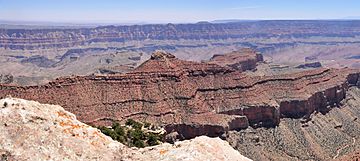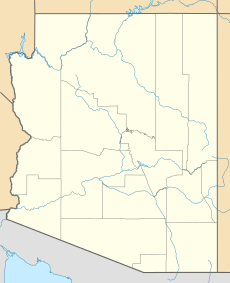Jupiter Temple facts for kids
Quick facts for kids Jupiter Temple |
|
|---|---|

West aspect, from Cape Final
|
|
| Highest point | |
| Elevation | 7,084 ft (2,159 m) |
| Prominence | 1,072 ft (327 m) |
| Isolation | 3.06 mi (4.92 km) |
| Parent peak | Freya Castle (7,288 ft) |
| Geography | |
| Location | Grand Canyon National Park Coconino County, Arizona, US |
| Parent range | Kaibab Plateau Colorado Plateau |
| Topo map | USGS Walhalla Plateau |
| Type of rock | sandstone, siltstone, limestone |
Jupiter Temple is a tall mountain peak in the Grand Canyon, located in northern Arizona, United States. It stands about 7,084 feet (2,159 meters) above sea level. This impressive summit is found in Coconino County.
Jupiter Temple is about one mile southeast of Cape Final, which is on the canyon's North Rim. It's also about 1.5 miles north-northwest of Apollo Temple. The mountain rises very steeply, about 4,400 feet (1,341 meters) from the Colorado River in less than four miles. This means it has a lot of topographic relief, which describes how much the land's height changes in a certain area.
The mountain is named after Jupiter, who was the most important god in Roman mythology. This naming tradition was started by Clarence Dutton, who named many places in the Grand Canyon after mythological gods and goddesses. The name "Jupiter Temple" was officially recognized in 1906 by the United States Board on Geographic Names. The area around Jupiter Temple has a cold semi-arid climate, which means it's usually dry and can have cold winters.
Understanding the Rocks of Jupiter Temple
The very top of Jupiter Temple is made of a type of rock called Coconino Sandstone. This sandstone formed during the Permian period, which was a very long time ago. Below this sandstone, you'll find layers of rock from the Supai Group. These rocks formed during both the Pennsylvanian and Permian periods.
Underneath the Supai Group, there's a thick layer of Redwall Limestone. This limestone forms tall cliffs and is from the Mississippian period. Even deeper, you'll find rocks from the Cambrian period, known as the Tonto Group. Finally, at the very bottom, near the Colorado River, are the oldest rocks, which are part of the Chuar Group from the Neoproterozoic era.
When it rains on Jupiter Temple, the water flows off the mountain. This runoff travels south and eventually reaches the Colorado River through Basalt and Unkar Creeks.
Images for kids
-
An aerial view of Jupiter Temple (on the left), Siegfried Pyre (in the upper left corner), and Apollo Temple (in the lower right). In Roman mythology, Apollo is Jupiter's son.







